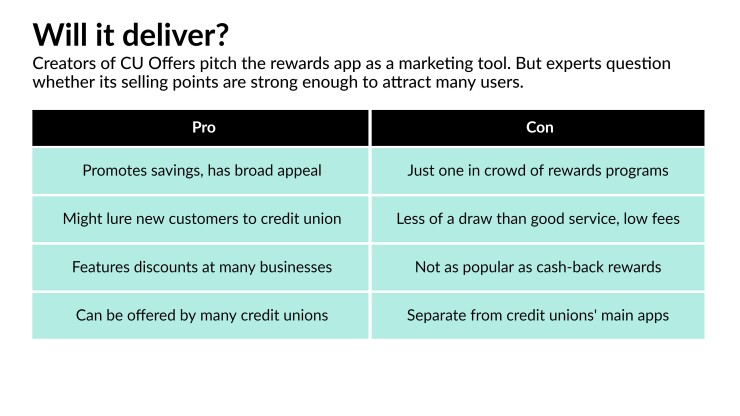Several credit union leagues have landed on an idea they hope will help them recruit new members and strengthen loyalty among current ones: a rewards app.
It’s a product of three leagues clustered in the Northeast but is meant to offer discounts and deals to members of credit unions across the country. Collaboration is common among credit union organizations because it helps them attain scale in ways they couldn’t on their own.
“Credit unions are at a market share disadvantage to banks, so the more that we can join forces, the greater competitive strength we have,” said Bruce Adams, president and CEO of the Credit Union League of Connecticut, which spearheaded the app.
A month into launch, CU Offers is being marketed by about 30 credit unions representing 400,000 members. The hopes are to attract new customers, especially employer groups, increase benefits for existing members and support small businesses as they recover economically from the pandemic.
As feedback rolls in, the makers will explore ways to bring other leagues into the fold.
Still, some experts are skeptical about the utility of a stand-alone rewards app, and whether such a tool is enough to reel in customers en masse or drum up meaningful usage.

Caroline Vahrenkamp, program manager of the research insights group at the analytics company Raddon, says a number of questions come to mind.
“How many of the members will download the app and remember they have access? How many people have discounts like this already? Will they see value?” she said.
The Credit Union League of Connecticut thought of the idea in the fall of 2020 and built it with the Association of Vermont Credit Unions and Cooperative Credit Union Association, which represent institutions in Delaware, Massachusetts, New Hampshire and Rhode Island. The three groups shared resources and jointly shouldered the costs.
The tool operates as an app and a web platform, where customers of any credit union can sign up and explore discounts from national retailers such as Ace Hardware, Dell and McDonald’s, as well as local businesses in sectors such as dining, entertainment and health. Users can also access prescription savings and search travel deals.
When location functionality is turned on, customers using the smartphone version will see discounts in their areas. In the future, the creators hope to enable push notifications to feed local offers directly to users’ phones, as they gather feedback from credit unions and their members. Credit unions may also be able to customize the app with their own branding.
Representatives from all three leagues met weekly to discuss the name, offers and branding they wanted to incorporate as they built the app with a third-party developer, which they declined to name.
One goal is to increase the number of benefits credit unions can extend to their members and bolster the membership base at credit unions.
“CU Offers is another tool to entice small businesses to be part of the credit union family” in the sense that they may find the addition of a discount app appealing, said Chris Whalen, vice president of marketing at the Credit Union League of Connecticut.
Another is to help local businesses recover from the pandemic by raising their profile through the app. In turn, the creators hope that more small businesses will be inspired to join the program and promote credit unions.
“We think it is far more effective for businesses to generate real transactions when the consumer is out in the world,” Adams said.
Adams and Whalen say CU Offers sets itself apart from other rewards programs in that there is no cost for members to join or requirement to pay for a premium checking account to access rewards; most offers on the app are free as well. Businesses can also list their discounts on the app for free. Although the creators have so far been focused on fleshing out offers in Northeastern states, where the leagues are based, any business in the country can register a discount.
Right now, the app will generate revenue from a few paid rewards such as subscriptions for identity theft protection services.
However, some experts question whether customers will use the service once they sign up and, in turn, whether businesses will find enough traction that they are motivated to join in large numbers.
“It will be interesting to see what the reaction will be from members,” said Peter Duffy, managing director at Piper Sandler. “Consumers are bombarded with apps and all kinds of marketing and advertising. After a while, how does stuff like that influence the consumer’s actions? I think a lot of companies are struggling to figure that out.”
Brian Boardman, a director in the advisory group at Fiserv, says that banks have made similar attempts to attract businesses in the past but largely didn’t succeed as businesses realized they weren’t picking up much activity from participating.
“At the end of the day, a business will switch financial institutions because they are getting better service, a better price, better loan terms,” Boardman said.
This kind of program could be more enticing if it was integrated into the credit union’s regular mobile app, rather than as a stand-alone product people have to download separately, Vahrenkamp said.
But the creators see the app as a meaningful way to solidify relationships with their communities.
“The key differentiator between us and other member-rewards programs is that credit unions give a voice to our members and ultimately will reflect their desires,” Whalen said. “This is credit union members and local small businesses banding together to lift all boats.”





